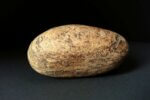One woman’s dramatic encounter with Christ shows us that he came to deliver women from spiritual oppression.
We
do not know her name. Usually we refer to her as “the woman with the
issue of blood.” But those words from the King James Bible seem archaic
today and make her seem faceless and distant. She was a real person, and
her pain was intense.
I sometimes imagine that this fragile
shell of a woman was called “Mara”–the Hebrew word for bitter. Chronic
sickness had disfigured her life. Yet Christ got so close to her pain
that she dared to touch Him, and her healing has provided inspiration
for countless sermons ever since.
You know the story. Her appearance in the Gospel of Mark is brief, but her encounter with Jesus, described in Mark 5:25-34,
is one of the most poignant in the New Testament. I fear we miss the
impact of this woman’s story because we don’t realize what she endured
or what her healing truly signifies.
The Bible tells us that she
had been bleeding for 12 years. We don’t know the nature of her illness,
but it is probable she had some type of female problem–almost like a
12-year-long menstrual period. She undoubtedly experienced chronic
fatigue, lack of energy and crippling grief.
We don’t know the
cause of her illness, either. But it is likely she could not bear
children because of it, and her childlessness would have brought even
more of a stigma in a primitive Jewish society than the illness itself.
Perhaps
she had suffered a painful miscarriage at one point. Perhaps her
husband divorced her because she could not bear children. The Bible
doesn’t tell us the details.
However, we do know that she “endured much at the hands of many physicians” and that she “spent all that she had” on doctors (Mark 5:26,
NASB)–meaning that she was destitute and may have been forced to beg.
The gospel account also says that the questionable medical help made her
physical condition worse, not better.
In the time of Jesus,
medical care for women in Mara’s condition was crude if not barbaric.
All the doctors in Jerusalem were men, of course. And their “treatments”
were nothing more than experiments based on superstition and flawed
science.
The Talmud and other Jewish writings prescribed various
cures for ailments–including one that called for ingesting dust mixed
with human waste. Mara may have been forced to eat such toxic substances
to find a cure. For her, doctor visits were torture.
Yet the
Gospel account tells us that when she heard that Jesus was passing near
her neighborhood, she mustered up the courage to press through the crowd
to reach Him. Did she do this simply because she was desperate? I
believe there is much more to this story. But we must read between the
lines.
This anguished woman had been brushed aside by rabbis,
abused by doctors and shunned by men on the street. Why then would she
suddenly feel the confidence to approach the rabbi named Jesus?
I
wonder if Mara had talked to others about Him. Surely she had heard the
reports of His healing power. Perhaps she also had met Mary of Bethany
in the marketplace or had talked to Mary Magdalene in an alley.
What
set this Teacher apart from all the religious leaders in Israel? And
why would Mara have dared to approach Him when she knew that all other
rabbis would have rebuked her–and perhaps punished her publicly–for
touching a holy man?
1. She knew Jesus was approachable.
Rabbis in Israel were generally aloof and inaccessible–and they kept
their distance from women. Ancient Jewish traditions instructed men to
walk on the other side of the street when they saw a woman approaching.
Superstition said that it was bad luck for a woman who was menstruating
to pass between two men.
The rabbis viewed women as the source of
all evil. They taught that because Eve was deceived in the Garden of
Eden, all females were guilty of ruining Creation. (Ironically, they did
not pass Adam’s guilt on to all males.) Women were considered
deceitful, lazy, fickle and ignorant–and prone to immorality and
witchcraft.
Women in ancient Israel were required to stay veiled
and silent. Under the best of circumstances they were not to be seen
associating with a rabbi. A menstruating woman–who was considered
ceremonially unclean–was expected to stay as far away as possible from a
man of God.
Yet Mara touched Jesus. I wonder if she had heard
from Mary of Bethany that this rabbi encouraged women to sit at His feet
and learn from the Scriptures–when other rabbis in Israel did not
allow women to participate in any form of religious instruction. Perhaps
Mara met the Samaritan woman, who carried on a lively theological
discussion with Jesus at Jacob’s well.
Or maybe she talked with the old woman whose back was healed by Jesus in the Temple (see Luke 13:10-17).
Jesus broke every religious rule of His day when he called that
disfigured saint from the women’s section in the back of the sanctuary
and allowed her to come to the front–where she declared her praises to
God.
Jesus created a scandal whenever He interacted with women.
Why? He intentionally broke every religious rule about women because
part of His mission on Earth was the dismantling of an ancient curse.
2. She knew that Jesus cared for her.
Other rabbis in Israel would have shown no compassion for a woman in
Mara’s condition. Jewish men often recited this prayer: “Lord, I thank
You that I am not a Gentile. I thank You that I am not a woman. I thank
You that I am not a slave.”
But Jesus didn’t say that
self-righteous prayer. He didn’t view women with disdain. In fact, He
had women followers (which was taboo in Israel), and he developed close
friendships with some of those women. He even allowed them to see Him
crying.
When a certain immoral woman poured expensive perfume on
Jesus and wiped His feet with her hair, Jesus did not chastise her like
other rabbis would have done (see Luke 7:36-50).
He spoke to her tenderly and declared that her sins were forgiven. When
a nameless woman was accused of adultery by a group of sanctimonious
Jewish men (see John 8:1-11), Jesus rushed to her defense and rebuked her accusers.
Mara knew that Jesus was different!
3. She knew Jesus wasn’t afraid of her condition.
Mara risked her life when she stepped into the dusty street and pressed
toward Jesus’ entourage. People who knew her were probably dumbstruck
by her forwardness. Some of the men escorting Jesus probably shouted at
her, “Go away, sick woman!”
But Mara knew that her bleeding was
not repulsive to Jesus. Something deep inside told her that this rabbi
wasn’t concerned about contagion. She said to herself, “If I just touch
His garments, I will get well” (Mark 5:28).
Staying low to the ground, unseen by Jesus’ disciples, she reached
through dozens of scurrying feet and grabbed the hem of Jesus’ robe.
Her
miracle came instantly. Her throbbing pain subsided. The hemorrhaging
stopped, and the soreness that had crippled her body for more than a
decade vanished. Perhaps she began to sob, but fear undoubtedly gripped
her when she realized that Jesus had stopped to ask who had touched Him.
Would He rebuke her? Would He give her a stern lecture about
Moses’ laws of hygiene? Would He banish her to the edge of town and tell
her never to come near Him again?
That would have been the reaction of any other rabbi in Jerusalem. But that is not what Jesus did.
His
disciples were amazed by His question. Why would Jesus ask, “Who
touched Me?” when everyone was seeking His attention? But Jesus knew
what had happened to Mara. When she reluctantly made eye contact with
Him, all the compassion in the universe stared back at her.
As
she knelt at His feet, trembling yet overwhelmed that her pain was gone,
she heard Him speak. His tone was not angry. “‘Daughter,'” He said,
breaking yet another religious rule that forbade rabbis to address women
in an endearing manner. “‘Your faith has made you well. Go in peace,
and be healed of your affliction'” (v. 34).
Not only was Mara
healed but also Jesus affirmed His love for her in front of everyone
else. The doctors who had taken her money may have witnessed the scene.
The rabbis who smugly avoided her may have been there to hear Jesus
encourage her. The men who had spat on her and called her names probably
hung their heads in shame.
Rabbi Jesus had spoken. He had changed all the rules.
THE POWER OF REDEMPTION
Mara’s
healing is significant because it was a prophetic sign of what Jesus
came to do for all women. We miss the full meaning when we view the
story as a mere display of the Messiah’s power over sickness.
Mara’s
chronic pain represents the state of all women under the curse of sin.
No doubt she was familiar with the story of mankind’s rebellion in the
Garden of Eden. She had heard the local rabbi read the story from the
scrolls of Moses.
After Adam and Eve ate from the forbidden tree,
God described to Eve how the curse of sin would affect her. He said:
“‘I will greatly multiply your pain in childbirth, in pain you will
bring forth children; yet your desire will be for your husband, and he
will rule over you'” (Gen. 3:16).
Mara certainly knew the pain of Genesis 3:16.
She probably winced when she heard those words as she listened from the
back of the synagogue, where all women were sequestered in Jesus’ day.
Mara had lived that verse. It described her existence.
Genesis 3:16
is a clear, prophetic description of how women would suffer in a fallen
world without a Savior. The pain it describes is not limited to that of
childbirth. It embodies all forms of feminine pain: miscarriage,
infertility, rape, abuse, incest, sexual slavery, domestic violence,
economic prejudice and even religious chauvinism.
Genesis 3:16
is not God’s perfect plan for women. On the contrary, it is the reason
women in Islamic countries are stoned in broad daylight by their own
husbands. It is the reason the genitals of African girls are brutally
mutilated. It is the reason Latino women suffer under the power of
machismo. It is the reason women around the world still do not have
access to education, health care or civil freedom.
Yet there is
good news. When Jesus the Messiah came to Earth, He did not come to set
only men free. He came to touch all the Maras of the world. He liberated
women from the power of sin’s curse. He defended them, bound up their
wounds, stopped their internal bleeding, removed their chronic pain and
restored their lost dignity.
Jesus was not afraid to identify
with women, and He did not refuse when God laid the essence of that
feminine pain on Him at Calvary. John 3:16 says He came because God “so loved the world.” I like to remind women that John 3:16 has nullified Genesis 3:16!
Mara
experienced this redemption 2,000 years ago. I pray that in our
lifetime millions of women around the world will come to understand that
the rabbi named Jesus is like no other.
J. Lee Grady is a contributing editor and former editor of Charisma.







Leave a Comment
You must be logged in to post a comment.